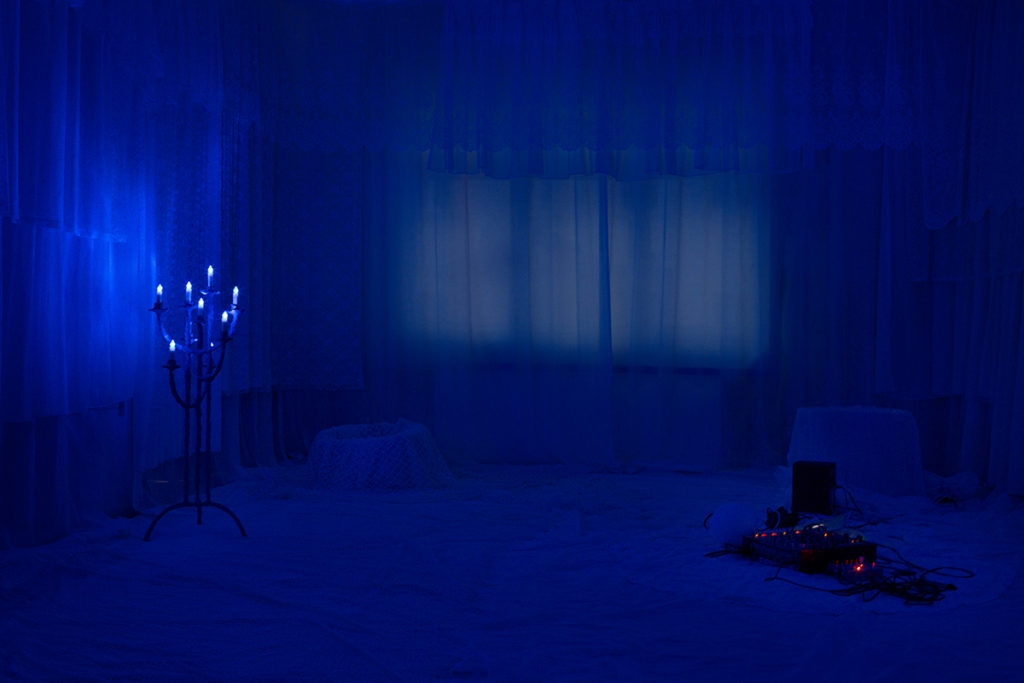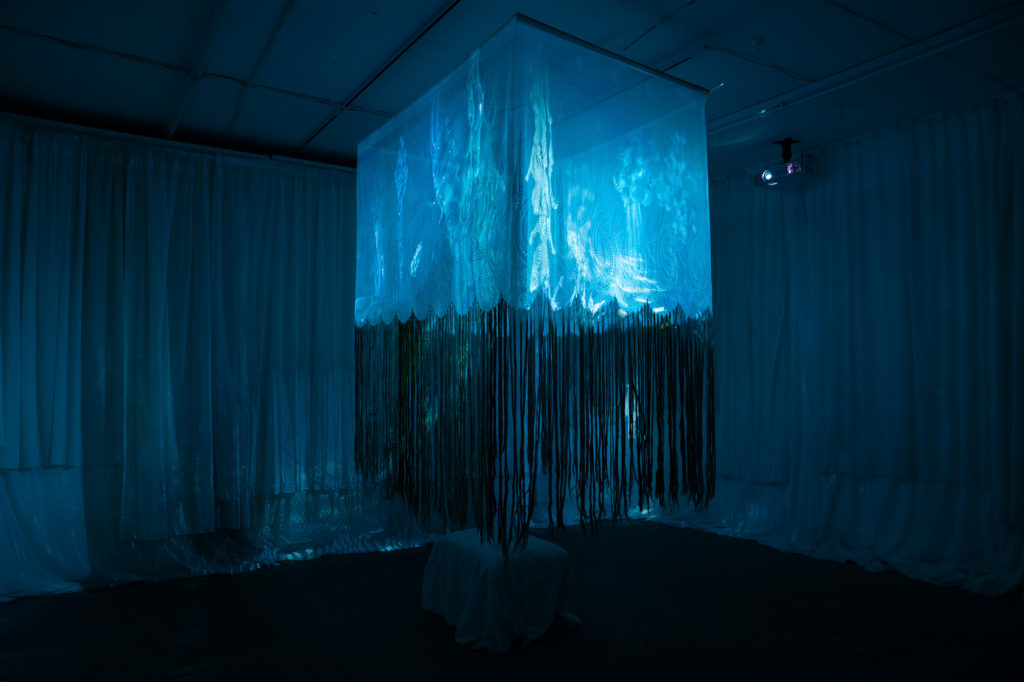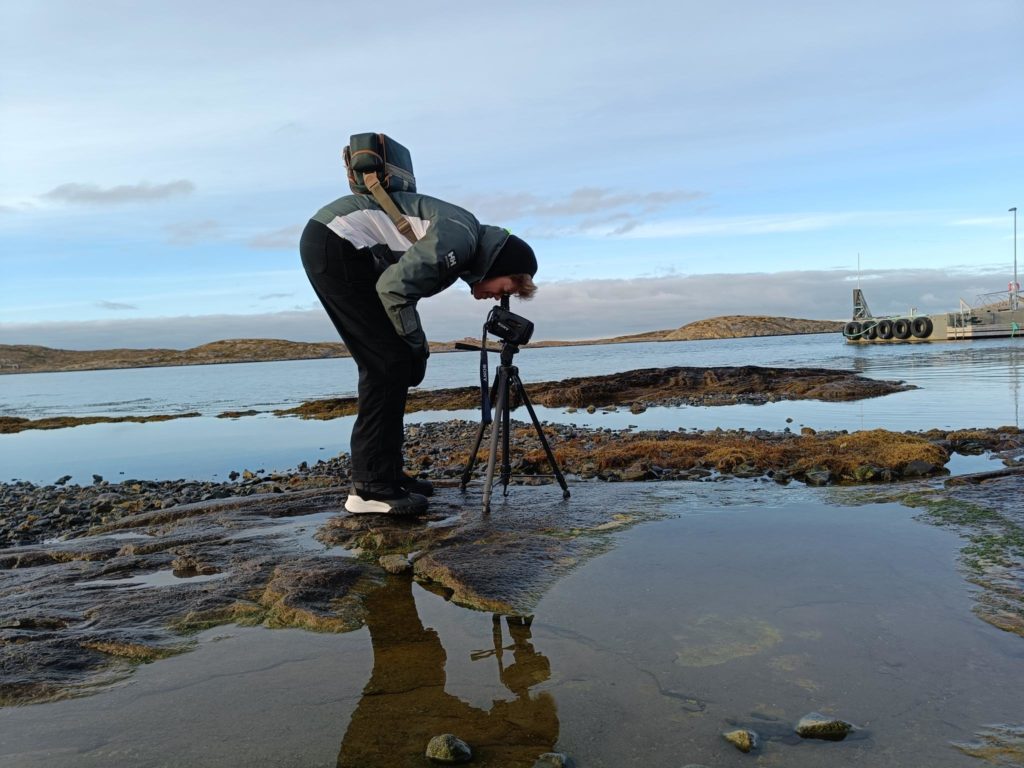I think I’m supposed to call myself a practice-based researcher and transdisciplinary artist, but really, that just means that I work mainly with textiles and incorporate a lot of DIY technology, circuits, audio, and video work into my practice. My research is currently looking at the idea of creeping as an artistic strategy and theoretical framework to move around in the spaces between textile and craft studies, trans visual culture, and trans studies. I also use creeping to think about how my textile tools, techniques and materials interact with each other and myself, and the way in which audiences access my work. It is also a way to rethink the negative connotations that are associated with ‘creeps’ and queer and trans people, and how this moniker is used to limit people from using or accessing public spaces.
This idea of creeping comes from the etymology of the word ‘smock’ (connected to the Old Norse and English word meaning ‘to creep into a garment), as I use smocking techniques to create large scale installations that combine domestic textiles with speculative underwater virtual environments. I work with sloppy techniques and discarded materials, and the pieces are intentionally messy. You will often see the loose threads and stitches, the mistakes and the reworkings. Here, sloppiness is not just meant as a binary opposite to the idea of formal craft skills, but rather an embodied knowledge and a way of negotiating with the world around us, felt through the physical and social process of making. Being a practice-based researcher means that, for me, the materials guide the work and whenever I feel stuck or lost in the research, getting my hands dirty usually helps me find a way through it.
I’ve included some images of installation works I made last year in collaboration with 2 other trans and non-binary artists, which focus on the idea of creeping and visibility.
‘love letters to watery others’ is an installation and performance piece in which audiences were invited into a ‘creepy meditation’ led by a tentacular drag entity called Lametta Gorgeous. During the meditation, people were encouraged to close their eyes, enter a speculative underwater world and rearrange their bodily organs to survive in this landscape.



‘kelp reflection room ii’ similarly invited people to enter a textile sculpture with a video of a virtual pulsating kelp forest projected on to it and become part of a speculative ecosystem. By placing focus on the audience as active participants within the installation, I am interested in how the idea of visibility can be reimagined.



Within the field of trans studies and trans-visual culture, the topic of visibility is often a contentious topic – the idea that increased visibility for trans people will lead to more understanding, education, and acceptance. Unfortunately, as we often see, this is not the case as the focus remains on identity and not on the material conditions and lack of access to resources and support. My research uses the idea of creeping to renegotiate the idea of visibility through a nuanced examination of the gaze to think about why and how people wish to surveil, define, and categorise trans people.
Image credits:
kelp reflection room ii, 2023
textile and digital installation (net curtains, cotton thread, wood, metal, video, and soundscape)
collaborator: wro wrzesińska
soundscape: Kevin Craig
photography: Dor Even Chen
love letters to watery others, 2023
textile installation (net curtains, cotton bed sheets, metal, clay, plastic candles, foam, multiple videos with audio)
collaborator: Mars Löffler
3d collaboration: Jack Perkins
photography: Lena Ures

Sam Godfrey is an AHRC funded 2nd year practice-based researcher in the Department of Art History and Visual Culture. They hold an MA in Textile Practice from the Manchester School of Art, MA Arts Administration & Cultural Policy from Goldsmiths College, and BA (Hons) American Literature and Creative Writing from the University of East Anglia. You can find more about their art, research and writing here and on Instagram @s_k_godfrey
